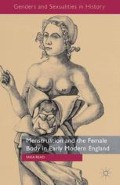Abstract
This chapter focuses on menarche, an event which was taken to mean that the body was sexually mature and physically ready for what ancient medicine, from which early modern medicine took its lead, claimed to be the next stage of the transition to womanhood. I will analyse the social and medical context in which a normal, timely menarche was written about in the early modern period, and situate this within the accounts of female adolescence more broadly, since menarche is part of a series of physical and emotional changes. According to the widely privileged Hippocratic teachings, the end of male puberty was a sudden affair, as the production of semen proved that the boy was sexually mature, ‘but in girls a more gradual series of events is necessary to complete the process of becoming a woman’.1 As discussed in the Introduction, Helen King has demonstrated how the Hippocratic text On Generation indicated that as a girl grew, the channels in her body were opened to make ‘a way through and a way outside’; as part of the growth to maturity, menarche was considered to be the first transitional bleeding.2
Access this chapter
Tax calculation will be finalised at checkout
Purchases are for personal use only
Preview
Unable to display preview. Download preview PDF.
Notes
Helen King, Hippocrates’ Woman: Reading the Female Body in Ancient Greece (London: Routledge, 1998), p. 72.
Edward Phillips, The New World of English Words; or, A General Dictionary (London: Nath. Brooke, 1658)
Will Greenwood, A Description of the Passion of Love Demonstrating its Original, Causes, Effects, Signes, and Remedies (London: William Place, 1657), pp. 81–2.
Helen King, The Disease of Virgins: Greensickness, Chlorosis and the Problems of Puberty (London: Routledge, 2004), p. 85.
John Carmi Parsons, ‘The Medieval Aristocratic Teenaged Female: Adolescent or Adult?’, in The Premodern Teenager: Youth in Society 1150–1650, ed. by Konrad Eisenbichler (Toronto: Centre for Reformation and Renaissance Studies, 2002), pp. 311–22
George Hakewill, An Apologie of the Power and Providence of God in the Government of the World (Oxford: John Lichfield and William Turner, 1627), p. 161.
Thomas Raynalde, The Birth of Mankind: Otherwise Named, The Woman’s Book, ed. by Elaine Hobby (Aldershot: Ashgate, 2009), p. 57.
Jane Sharp, The Midwives Book; or, The Whole Art of Midwifry Discovered, ed. by Elaine Hobby (Oxford: Oxford University Press, 1999), p. 215.
John Freind, Emmenologia, trans, by Thomas Dale (London: T. Cox, 1729), p. 1.
Henry Fielding, Joseph Andrews and Shamela, ed. by Douglas Brooks-Davies (Oxford: Oxford University Press, 1999), p. 134.
Benjamin Albyn, An Appeal to God and the King: Together with a True Narrative of Unparallel ‘d Grievances (London: B Albyn, 1697), p. 7.
Amy Louise Erikson, Women and Property in Early Modern England (London: Routledge, 1993), p. 120.
Edward Semple Le Compte, The Notorious Lady Essex (London: Robert Hale, 1970), p. 21.
Sarah Toulalan, ‘“Unripe Bodies”: Children and Sex in Early Modern England’, in Bodies, Sex and Desire from the Renaissance to the Present, ed. by Kate Fisher and Sarah Toulalan (Basingstoke: Pal grave, 2011), pp. 131–51
Lois W. Banner, In Full Flower: Aging Women, Power, and Sexuality (New York: Random House, 1993), p. 153.
Tim Hitchcock, English Sexualities, 1700–1800 (Basingstoke: Macmillan, 1997), p. 25.
Bernard Capp, When Gossips Meet: Women, Family, and Neighbourhood in Early Modern England (Oxford: Oxford University Press, 2003), p. 4.
Robert Burton, The Anatomy of Melancholy (Oxford: Henry Cripps, 1621), p. 541.
Thomas Willis, An Essay of the Pathology of the Brain and Nervous Stock in which Convulsive Diseases are Treated of Being the Work of Thomas Willis, trans, by Samuel Pordage (London: D. Tring, 1681), p. 21.
Linda A. Pollock, With Faith and Physic: The Life of a Tudor Gentlewoman Lady Grace Mildmay, 1552–1620 (New York: Collins and Brown, 1993), p. 110.
Mina K. Dulcan, Dulcan’s Textbook of Child and Adolescent Psychiatry (Arlington, VA: American Psychiatric Publishing, 2009), p. 450.
Alice Thornton, ‘From A Book Of Remembrance, c. 1668’, in Her Own Life: Autobiographical Writings by Seventeenth-Century Englishwomen, ed. by Elspeth Graham, Hilary Hinds, Elaine Hobby and Helen Wilcox (London: Routledge, 1989), pp. 145–62
Richard Boulton, An Examination of Mr. John Colbatch His Books (London: A. and J. Churchill, 1698), p. 153.
Sara Mendelson and Patricia Crawford, Women in Early Modern England, 1550–1720 (Oxford: Oxford University Press, 1998), p. 79.
John Loftis, ed., The Memoirs of Anne, Lady Halkett and Ann, Lady Fanshawe (Oxford: Clarendon Press, 1979), p. 109.
John Marten, A Treatise of All theDegrees and Symptoms of the Venereal Disease, in Both Sexes, 6th edn (London: S. Crouch, 1708), p. 172.
Author information
Authors and Affiliations
Copyright information
© 2013 Sara Read
About this chapter
Cite this chapter
Read, S. (2013). ‘Having the Benefit of Nature’: Menarche and Female Adolescence. In: Menstruation and the Female Body in Early Modern England. Genders and Sexualities in History. Palgrave Macmillan, London. https://doi.org/10.1057/9781137355034_3
Download citation
DOI: https://doi.org/10.1057/9781137355034_3
Publisher Name: Palgrave Macmillan, London
Print ISBN: 978-1-349-47003-7
Online ISBN: 978-1-137-35503-4
eBook Packages: Palgrave History CollectionHistory (R0)

